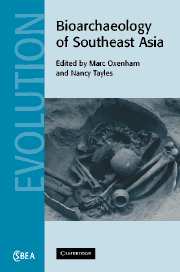Book contents
- Frontmatter
- Contents
- List of contributors
- Foreword: Emerging frontiers in the bioarchaeology of Southeast Asia
- Preface
- 1 Introduction: Southeast Asian bioarchaeology past and present
- Part I Morphological diversity, evolution and population relationships
- 2 The population history of Southeast Asia viewed from morphometric analyses of human skeletal and dental remains
- 3 A multivariate craniometric study of the prehistoric and modern inhabitants of Southeast Asia, East Asia and surrounding regions: a human kaleidoscope?
- 4 Interpretation of craniofacial variation and diversification of East and Southeast Asians
- 5 New perspectives on the peopling of Southeast and East Asia during the late upper Pleistocene
- 6 Human variation and evolution in Holocene Peninsular Malaysia
- 7 Dentition of the Batak people of Palawan Island, the Philippines: Southeast Asian Negrito origins
- Part II Health, disease and quality of life
- Part III Conclusions
- Index
- References
5 - New perspectives on the peopling of Southeast and East Asia during the late upper Pleistocene
Published online by Cambridge University Press: 18 November 2009
- Frontmatter
- Contents
- List of contributors
- Foreword: Emerging frontiers in the bioarchaeology of Southeast Asia
- Preface
- 1 Introduction: Southeast Asian bioarchaeology past and present
- Part I Morphological diversity, evolution and population relationships
- 2 The population history of Southeast Asia viewed from morphometric analyses of human skeletal and dental remains
- 3 A multivariate craniometric study of the prehistoric and modern inhabitants of Southeast Asia, East Asia and surrounding regions: a human kaleidoscope?
- 4 Interpretation of craniofacial variation and diversification of East and Southeast Asians
- 5 New perspectives on the peopling of Southeast and East Asia during the late upper Pleistocene
- 6 Human variation and evolution in Holocene Peninsular Malaysia
- 7 Dentition of the Batak people of Palawan Island, the Philippines: Southeast Asian Negrito origins
- Part II Health, disease and quality of life
- Part III Conclusions
- Index
- References
Summary
Introduction
Palaeogeographical studies show constant temporal changes of the environment, particularly during the Pleistocene, and emphasise the important effects of such variability on floral and faunal development and adaptation (Fairbridge 1961, van Heekeren 1972, Shackleton and Opdyke 1973, Farrell and Clark 1976, Dunn and Dunn 1977, Chappell and Shackleton 1986, Gibbons and Clunie 1986, Kershawa 1988, Ferguson 1993, Robert and Wright 1993). The close of the Pleistocene was characterised by several cold period peaks at approximately 60,000, 30,000 and 18,000 years BP. During these cold periods, sea levels dropped at least 125 m from current levels (Shackleton and Opdyke 1973, Kershawa 1988, Robert and Wright 1993, Stringer 1993), exposing large areas of land including the Sunda shelf in Southeast Asia (Figs. 1.1, p. 5 and 1.2, p. 6). During the last glaciation, the Japanese archipelago, Taiwan, Malaysia, parts of the Philippine islands and the Indonesian archipelago were connected to the Asian continent (Fairbridge 1961, Shackleton and Opdyke 1973, Dunn and Dunn 1977, Chappell and Shackleton 1986, Demeter 2000, Robert and Wright 1993), providing an unbroken land route from Japan to Indonesia. Climate changes associated with periods of peak glaciation had marked effects on the flora and fauna. For instance, palynological analyses (Frenzel 1968, Kershawa 1988, Robert and Wright 1993) show that drops in temperature were associated with the replacement of species by others better adapted to cold and aridity.
- Type
- Chapter
- Information
- Bioarchaeology of Southeast Asia , pp. 112 - 132Publisher: Cambridge University PressPrint publication year: 2006
References
- 3
- Cited by



